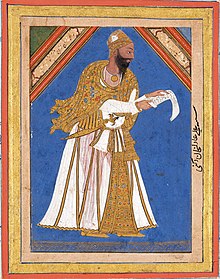Ali Adil Shah I
This article includes a list of general references, but it remains largely unverified because it lacks sufficient corresponding inline citations. (March 2012) |
| Ali Adil Shah I | |||||
|---|---|---|---|---|---|
| Sultan | |||||
 | |||||
| Reign | 1558–1579 | ||||
| Predecessor | Ibrahim Adil Shah I | ||||
| Successor | Ibrahim Adil Shah II | ||||
| Died | 1579[1] Bijapur | ||||
| Burial | Ali Ka Rouza | ||||
| Spouse | Chand Bibi | ||||
| Issue | Ibrahim Adil Shah II the adopted son. | ||||
| |||||
| House | House of Ali | ||||
| Dynasty | Adil Shahi Empire | ||||
| Father | Ibrahim Adil Shah I | ||||
| Mother | Daughter of Asad Khan Lari (Khusrow) | ||||
| Religion | Shia Islam | ||||
Ali Adil Shah I (1558–1579) was the fifth Sultan of Bijapur Sultanate.
On the day of his coronation Ali abandoned the Sunni practices and reintroduced the Shi’ah Khutbah and other practices. The Persian doctors of religion were granted full freedom to preach the Shi’ah doctrine and were paid by the State for their missionary activities.
The new Sultan restored back to power the Afāqis while relegating the Deccanis to a position of insignificance. He subverted all the dogmatic experiments which his father had practiced.

Marriage[]
He married the famous woman warrior Chand Sultana, daughter of Nizam Shahis of Ahmadnagar.
Reign[]
During Ali's reign Bijapur and Vijayanagar came very close to each other and Ali actually paid a visit to Vijayanagar City, where Ramaraya received him with great pomp and honour. The greatest event of Ali's reign was the successful formation of the confederacy of the Deccan Sultans against Vijayanagar and their victory over the latter at the Battle of Rakkasagi – Tangadagi in Talikoti in 1565. As a result of this battle Bijapur’s southern boundary was extended right up to the city of Vijayanagar, and further it opened the gates for the future expansion of Bijapur further south. Consequently, at the end of Ali's reign, the Bijapur Kingdom extended up to port of Honavar on the west coast and southern boundary extended along the line of Varada and Tungabhadra rivers.
Developments[]
During Ali's reign diplomatic relations with the Mughal Emperor Akbar were established and envoys were exchanged.
Succession[]
In 1579, Ali having no son, appointed his nephew Ibrahim, son of his brother Tahamasif, as his successor. In the same year, Ali was assassinated by a eunuch,[2] and was buried in Ali Ka Rouza near Sakaf Rouza in Bijapur.
References[]
- ^ Page 2 of Translator's Preface in the book Tohfut-ul-mujahideen: An Historical Work in the Arabic Language originally written by Zayn al-Dīn b. ʿAbd al-ʿAzīz al- Malībārī (Translated into English by Lt. M.J. Rowlandson
- ^ Tohfut-ul-mujahideen: An Historical Work in the Arabic Language By Zayn al-Dīn b. ʿAbd al-ʿAzīz al- Malībārī (Translated into English by Lt. M.J. Rowlandson)
- Wakiyate Mamlakate Bijapur by Basheeruddin Dehelvi.
- Tareekhe Farishta by Kasim Farishta
- External Relation of Bijapur Adil Shahis.
- 1579 deaths
- Sultans of Bijapur
- Adil Shahi dynasty
- 16th-century Indian monarchs
- 1579 in India
- 1558 in India
- Indian Muslims
- 1558 births
- Murdered Indian monarchs
- Converts to Shia Islam from Sunni Islam
- Critics of Sunni Islam
- 16th-century murdered monarchs